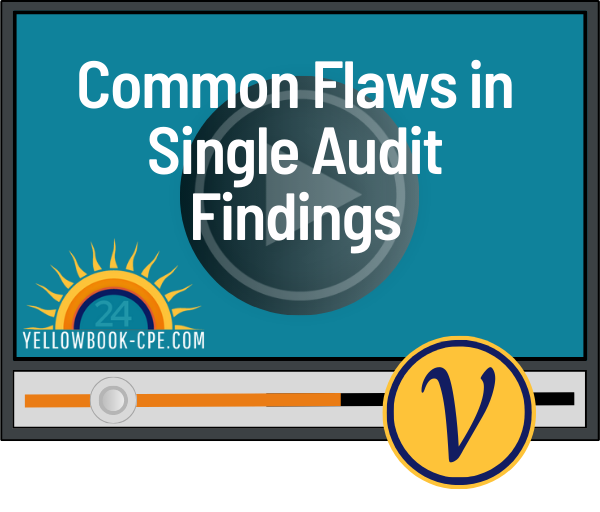Description
Common Flaws in Single Audit Findings – Video Course includes an online video and self study e-book for 4 hours of CPE credit.
In this short video, we will learn how to support single audit findings with solid evidence and properly classify issues so that grantors can get the most use out of your audit report.
The Uniform Guidance and Yellow Book are full of instructions for creating audit findings. But the instructions do not highlight the nuances and pitfalls of developing and supporting a convincing finding.
Solid cause and effect statements are particularly elusive. And classifying the reportable condition as a fraud, as an internal control weakness, or as material non-compliance can be tricky.
Course objectives include:
- Determine the purpose of a single audit finding
- Define the required elements of a finding
- Identify qualities of a compelling effect statement
- Identify unhelpful and rude cause statements
- Sequence the three phases of editing
- Determine which elements of a finding must be supported by testing
- Distinguish between a control test and a test of compliance
- Discern the strengths and weaknesses of different types of evidence to support your findings
- Identify the qualities of a helpful recommendation
- Classify reportable conditions into types
- Identify qualities of an enticing finding title
CPE Credit Hours: 4
NASBA Category of Study: Auditing (Governmental)
Program level: Basic
Prerequisites: None
Advance preparation: None
Who should attend: Auditors
Instructional method: Video with online qualified assessment. QAS SS
Author: Leita Hart-Fanta, CPA
This course is also included in the Single Audit Bundle.
This course does qualify for the 24 hour Yellow Book CPE requirement.
Questions? You can find our FAQ here.
What People Say About This Course
“[I]t was very well done and I could relate well to the discussion.” – State Agency Internal Auditor
“Helps me understand why I am doing what I am doing.” – CPA in Public Practice
“If I discover any Single Audit findings, I will have an easier time writing them up and they will be more professionally presented.” – CPA in Public Practice


 Yellowbook-CPE.com is registered with the National Association of State Boards of Accountancy (NASBA) as a sponsor of continuing professional education on the National Registry of CPE Sponsors. State boards of accountancy have final authority on the acceptance of individual courses for CPE credit. Complaints regarding registered sponsors may be submitted to the National Registry of CPE Sponsors through its website:
Yellowbook-CPE.com is registered with the National Association of State Boards of Accountancy (NASBA) as a sponsor of continuing professional education on the National Registry of CPE Sponsors. State boards of accountancy have final authority on the acceptance of individual courses for CPE credit. Complaints regarding registered sponsors may be submitted to the National Registry of CPE Sponsors through its website: